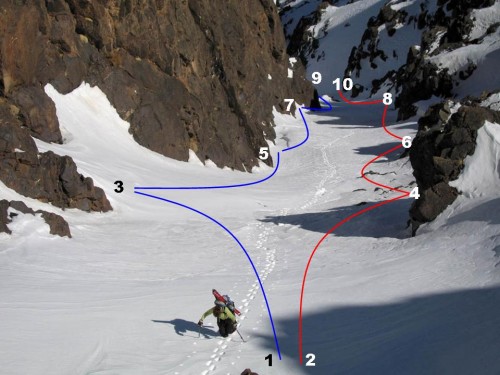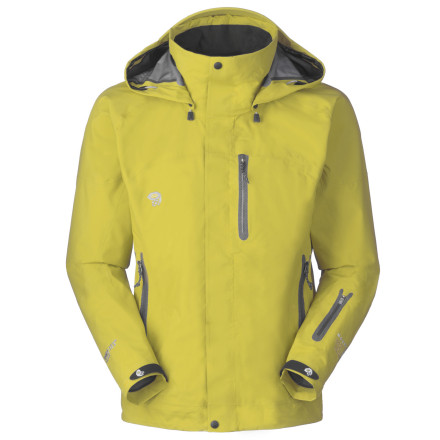Leapfrogging to Safety
Whenever possible, I prefer to ski a couloir or avalanche exposed shot in leapfrogging segments. The idea is that one person skis, then tucks out in a safe spot and watches the other person, then they do the same. Ideally, the stopping points will be staggered so that you can see your partner at all times as they are coming towards you and going by.

Polly booting up a couloir in the Atlas Mountains, Morocco. The numbers illustrate the sequence of descent and are probably exaggerated for this particular couloir - it could be done with about half the stops.
This process keeps the ski descent moving along quickly (time is of the essence in avalanche terrain) and allows both people to have clean lines. Another benefit is that you are never very far removed from your partner should they get caught in a slide. Skiing an entire shot all at once is great for minimizing your exposure, but if the following partner gets caught in a slide that buries him/her halfway up the chute, being down at the bottom means a long, slow hike to get back up.
One of the keys to doing this style of skiing is to have the first person only ski a short half-shot to begin with, which then sets the team up for the rest of the descent. It may not be the most social way to ski, but it is safer and efficient. When you are done, you can always talk at the bottom.
________________________________
Help support StraightChuter.com and leapfrog in style with a frog-green Mountain Hardwear Vertical Jacket from Backcountry.com. Click on the photo below…
Category: 07 Avalanche Avoidance










Hi Andrew,
Do you mean to say that you first boot up against the hazard and then worry about the hazard while then skiing down? I would never climb against or under the hazard unless I had confidence in my safe avalanche hazard evaluation.
Top-down on hazardous terrain is the habit formed in my avy control work experience. In other words, find a ridge/ safe route up or be very sure of the safe hazard level. The habit of skiing from safety-to-safety is good practice. From my avy control days I fall into old habits such as occasionally turning out of a perfectly nice run to look back and up, and the very strange habit that I have when concerned of cutting across and grabbing a small tree!
another benefit to the leapfrog is if you each have a camera- you can get great shots of eachother skiing past.
Good tips Andrew. I’d add that quite a bit of this style might be psychological in benefit as opposed to simply taking turns skiing the whole line, but good point about perhaps having to hike back up the couloir if something bad happens (though the kind of stuff you ski, if it flushes you’ll probably be fine hanging out at the bottom to pick up the pieces). I also like the leapfrogging when I don’t have the legs to nonstop the line. Those rests can really make the run go better, prevent falls, etc. Essential technique for guiding as well, so you can stay close to your client to offer tips, encouragement, and such. And yep, good for photos too!
Hi Randonnee – I’m the first to admit that booting straight up a chute makes a lot more sense when you are doing it than on paper/pixels. Obviously, if you are front and center (as the booter in the photo shows) for two hours, you stand a good chance of getting hit if anything comes down. I guess the saving grace is that when I boot up something, I get a good feel for what it is like. Just yesterday we were booting up a chute and it slowly got deeper… and deeper, and then at one point we all decided it wasn’t a good idea to go on.
But, as far as leap frog skiing, I think that turns stress the snow pack a lot more, plus you are covering a lot more ground, so you are more likely to hit a weak spot. I’ve avoided a few accidents considering the snowpack guilty until proven innocent and always trying to find a safe spot just as a matter of habit.
I was skiing at Whistler (in bounds, poor form, whatever) in a guided group during super extreme avalanche risk this winter. Says one group member “We’re not in any avalanche danger here, are we?” As I pressed myself harder against the wall, my only response was “Uhhhh” since I didn’t want to make the instructor look bad. The sad part was one of the main runs (Jersey Cream) was closed by ski patrol, but people didn’t see a hazard on the run so they were freely ducking the rope, but they were in prime avy runout… And there had been an inbounds avalanche at Whistler the day before…
– R